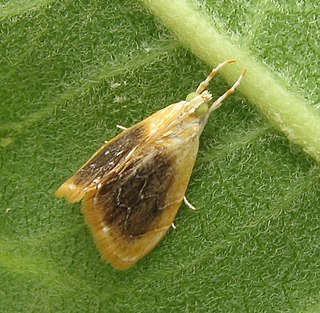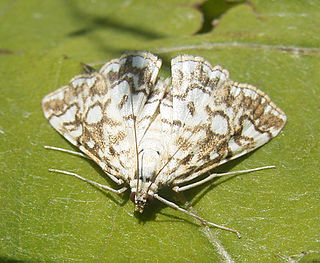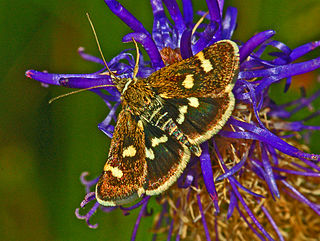
Pyraustinae is a large subfamily of the lepidopteran family Crambidae, the crambid snout moths. It currently includes over 1,400 species, the majority of them tropical but some found in temperate regions including both North America and Europe.

Spilomelinae is a very large subfamily of the lepidopteran family Crambidae, the crambid snout moths. They were formerly included in the Pyraustinae as tribe Spilomelini; furthermore taxonomists' opinions differ as to the correct placement of the Crambidae, some authorities treating them as a subfamily (Crambinae) of the family Pyralidae. If this is done, Spilomelinae is usually treated as a separate subfamily within Pyralidae. The Spilomelinae are believed to be polyphyletic. Many genera are only tentatively placed here even at this point.

Diathrausta is a genus of moths of the family Crambidae. The genus was described by Julius Lederer in 1863.

Goniorhynchus is a genus of moths of the family Crambidae.
Gonocausta is a genus of moths of the family Crambidae. The genus was first described by Julius Lederer in 1863.
Microthyris is a genus of pyraloid moths, belonging to the subfamily Spilomelinae of the grass moth family (Crambidae). The genus was first described by Julius Lederer in 1863.
Pantographa is a genus of moths of the family Crambidae described by Julius Lederer in 1863.
Petrophila is a genus of moths of the family Crambidae. The genus was described by Lansdown Guilding in 1830.
Rhectosemia is a genus of moths of the family Crambidae described by Lederer in 1863.
Synclera is a genus of moths of the family Crambidae described by Julius Lederer in 1863.

Glaphyria fulminalis, the black-patched glaphyria, is a species of moth of the family Crambidae described by Julius Lederer in 1863. It is found in the eastern part of the United States, from Connecticut to Florida, west to Texas and Illinois.

Parotis suralis is a moth of the family Crambidae. The species was first described by Julius Lederer in 1863. It is found around the west Pacific Rim, including the Chagos Islands, Hong Kong, Japan, Kiribati, Tuvalu and the tropical far north of Queensland.

Acentropinae is a fairly small subfamily of the lepidopteran family Crambidae, the crambid snout moths. Species of this subfamily are exclusively found in wetlands and aquatic habitats.

Odontiinae is a subfamily of moths of the family Crambidae. The subfamily was described by Achille Guenée in 1854.
Rhimphalea sceletalis is a small moth in the family Crambidae that is found in Queensland in Australia and in Papua New Guinea. The species was first described by Julius Lederer in 1863.
Glyphodes doleschalii is a moth of the family Crambidae described by Julius Lederer in 1863. It is found in Queensland in northern Australia.
Ostrinia obumbratalis, the smartweed borer, is a moth in the family Crambidae. It was described by Julius Lederer in 1863. It is found in North America, where it has been recorded from New Brunswick and Manitoba to Louisiana and Florida.
Caprinia felderi is a moth in the Crambidae family. It was described by Julius Lederer in 1863. It is found in India (Assam), on Java and Ambon Island, as well as in Australia, where it has been recorded from Queensland.

Cydalima pfeifferae is a moth in the family Crambidae. It was described by Julius Lederer in 1863. It is found in India, Myanmar, Singapore, Indonesia, Taiwan and Australia, where it has been recorded on Queensland.
Goniorhynchus gulielmalis is a moth in the family Crambidae. It was described by William Jacob Holland in 1900. It is found on Buru in Indonesia.










